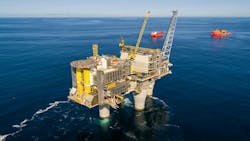Editor's note: This Global E&P section first appeared in the July/August 2024 issue of Offshore magazine.
By Jeremy Beckman, Editor, Europe
GULF OF MEXICO
Beacon Energy has produced first oil from the Winterfell field via a 13-km (8-mi) subsea tieback to the Heidelberg spar platform. The initial three wells should produce at around 20,000 boe/d, with two more to follow. Winterfell is in 5,400 ft (1,600 m) of water in a Miocene interval in the Green Canyon area: the current first-phase development is designed to recover around 100 MMboe.
***
Eni’s recent Yopaat discovery in Mexico’s Sureste basin could contain up to 400 MMboe of oil and associated gas. The Yopaaat-1 EXP well was drilled in 525 m (1,722 ft) of water in Pliocene/Miocene sequences in Block 9, 63 km (39 mi) offshore. Eni is considering a new hub development that would encompass Yopaat and its earlier finds in nearby Blocks 7 and 10, with an estimated overall resource of more than 1.3 BBoe.
Pemex and partners Talos Energy, Wintershall Dea and Harbour Energy have awarded DORIS the FEED for their 600-800 MMboe Zama field development offshore Mexico. Plans call for two platforms, 68 km (42 mi) of pipelines and cables, and a new onshore terminal, with the gas used for onshore power generation. At peak, Zama could deliver up to 180,000 b/d, equivalent to around 10% of Mexico’s present oil production.
CARIBBEAN SEA/BRAZIL
Shell has taken FID on the Manatee gasfield development in Trinidad and Tobago’s East Coast Marine Area. The field is part of the Loran-Manatee structure proven in 1983, with the Loran section in Venezuelan waters. Shell plans a normally unattended installation platform with eight wells, exporting the gas through a 110-km (68-mi), 32-in subsea pipeline to the company’s onshore Beachfield processing complex. Some of the volumes will head to the Atlantic LNG plant for export, with the remainder harnessed for domestic use. Mantee should go onstream in 2027, with production peaking at around 104,000 boe.d.
***
Seatrium will provide the two new FPSOs for Petrobras’ Atapu and Sepia fields in the pre-salt Santos basin. The P-84 and P-85 platforms will each produce 225,000 b/d of oil from locations 200 km (124 mi) offshore Rio de Janeiro, in water depths of over 2,000 m (6,562 ft). Seatrium has appointed CIMC Raffles in China to construct the two hulls; the topsides modules, to be built at yards in Brazil, China and Singapore, will undergo integration and commissioning in Singapore.
For the Búzios 9 development in the same basin, Petrobras has commissioned Subsea 7 to supply and install 102 km (63 mi) of rigid risers and flowlines for the steel lazy wave production system. Offshore operations should take place during 2026-27.
WEST AFRICA
Woodside Energy has produced first oil from Senegal’s deepwater Sangomar field. The FPSO Léopold Sédar Senghor, moored around 100 km (62 mi) offshore, will be connected under the current Phase 1 development to 24 producer and injector wells, with the subsea infrastructure designed to accommodate future expansion phases. The platform can produce up to 100,000 b/d of oil, with 1.3 MMbbl of storage capacity.
***
TGS, with support from the National Oil Company of Liberia (NOCAL), has started the second phase of reprocessing of legacy 2D seismic data over the offshore Liberia and Harbour basins. The company then plans to reprocess 15,616 sq km (6,029 sq mi) of 3D seismic in the Liberia basin. The goal is to provide continuous seismic attributes of higher confidence at target levels throughout the margin, TGS said, to support future offshore licensing rounds.
***
Chevron has signed production-sharing contracts for blocks EG-06 and EG-11 off Equatorial Guinea, over acreage close to the Zafiro field, formerly operated by Exxon Mobil. This builds on the producing offshore Alen and Aseng fields which came with Chevron’s acquisition of Noble Energy. And the company has reportedly signed risk service contracts for ultra-deepwater blocks 49 and 50 off Angola, in partnership with Sonangol.
Sonangol is also a partner in the newly sanctioned two-phase Kaminho oil development in Block 20/11 in Angola’s Kwanza basin, covering the Cameia and Golfinho fields. Operator TotalEnergies has awarded Saipem contracts totalling $3.7 billion to convert a VLCC to an FPSO, operate and maintain it over a 12-year period, and engineer/install the SURF facilities. These will include 30 km (18.6 mi) of 8-in. and 10-in, flowlines, risers and umbilicals. SLB OneSubsea will provide the 13 subsea well sets. First oil should flow in 2028 at a rate of 70,000 b/d.
NORTH SEA
Equinor and its partners have earmarked over $1.13 billion for new infrastructure to sustain gas production from the Troll West area of the Norwegian North Sea, safeguarding supplies to mainland Europe. Stage 2 of the Troll Phase 3 project will involve drilling eight new wells from two new templates, collectively producing 20 MMcf/d, and installing a new gas flowline between the facilities and the Troll A platform. The investment should add around 55 bcm to overall gas production from the Troll field, with the first of the new wells set to go online at the end of 2026.
In the same area, SLB has a FEED contract from Equinor for a 12-well, all-electric subsea production system for the Fram Sør field development. It will be the first application of a JIP that started in 2018 to develop new electrification technology via a standardized solution, in this case SLB’s standard subsea tree design upgraded with a fully electric power, control and actuation system.
***
TotalEnergies will sell its west of Shetland E&P interests to London-based Prax Group, pending approvals. These include operatorship of the producing Laggan, Tormore and Edradour fields, the onshore Shetland Gas Plant, and nearby offshore exploration licenses. TotalEnergies’ share of the fields’ current production is around 7,500 boe/d: the Laggan-Tormore pipeline system, which the company developed, will shortly also accommodate gas from Shell’s Victory field.
MIDDLE EAST
Carlyle International Energy Partners will acquire Energean’s E&P portfolio in Egypt (which includes producing fields in the Gulf of Suez) and other interests offshore Italy and Croatia. Subject to approvals, the deal, valued at up to $945 million, should go through by the end of the year. Carlyle will gain 2P reserves of 150 MMboe and net production of 34,000 boe/d.
***
Offshore the UAE, ADNOC has agree to transfer a 3% interest in the producing SARB and Umm Lulu concessions to Azerbaijan’s state oil company SOCAR; the two already collaborate in the Absheron gas-condensate field in the Caspian Sea. And PTTEP has agreed to acquire Wintershall Dea’s 10% stake in the Ghasha concession offshore western Abu Dhabi which houses multiple development projects.
EAST AFRICA
Tanzania’s Petroleum Upstream Regulatory Authority has approved TGS to manage and license the country’s offshore subsurface data. Previous exploration led to various large gas discoveries in various plays. TGS has exclusive rights to license all the data on behalf of the government, to reprocess existing data, and to acquire new seismic. And it will support Tanzania’s future licensing rounds that are planned to take place from 2025 onwards.
***
Mozambique’s government has awarded CNOOC and its subsidiaries petroleum exploration and production concession contracts for five offshore blocks, AG-D, E and G, and SG-A and B. These span a total area of 29,000 sq km i(11,197 sq mi) n water depths from 500 to 2,500 m (1,640-8,202 ft). The initial exploration terms run for four years.
ASIA-PACIFIC
Larsen & Toubro is managing the eighth phase of ONGC’s PRP-VIII Group B pipeline project offshore western India. The EPCIC program covers 129 km (80 mi) of subsea pipelines and associated modifications across ONGC’s west coast offshore fields and facilities.
***
Sapura OMV Upstream, in partnership with Sarawak Shell and Petronas Carigali, has produced first gas from the Jerun field in Block SK 408, 160 km (99.4 mi) north-west of Bintulu, Sarawak. The central processing platform can handle up to 550 MMcf/d of gas and 15,000 b/d of condensate, with the gas sent through a new 80-km (49.7-mi) pipeline to the E11RB production hub for onward delivery to Bintulu and Malaysia LNG.
Malaysia Petroleum Management (Petronas) has awarded a late life asset production sharing contract to Petra Energy Development for the Banang field offshore Peninsular Malaysia. Banang came onstream in 2014 under a three-field cluster Small Field Risk Service Contract. Petra will manage production on behalf of Petronas under the new late-life contract arrangement.
***
CNOOC has discovered oil and gas in Mesozoic volcanic rocks offshore eastern Bohai Bay, China. The LK7-1-1 exploratory well on the Longkou 7-1 prospect, in 26 m (85 ft) water depth, was drilled and completed at a depth of 4,400 m (14,435 ft) . It encountered 76 m (249 ft) of oil and gas pay zones and flowed close to 1 MMcm/d of gas, a new record in Bohai Bay.
In the Beibu Gulf area of the South China Sea, the company has started production from the Wushi 23-5 oilfields project in 28 m of water through two new wellhead platforms. This is China’s first offshore oilfield development to receive power from shore. CNOOC plans a total of 28 oil wells and 15 water injectors, with peak production of around 18,100 boe/d of light crude.
***
New Zealand’s Coalition Government is seeking to lift the ban on new petroleum exploration outside onshore Taranaki, North Island that the previous administration introduced in 2018. The Government is said to be keen for E&P companies to resume exploration in the main offshore fields that supply most of the country’s gas, in order to counteract a projected sustained decline. It will submit the Crown Minerals Amendment Bill, including changes to the petroleum exploration applications process, to Parliament later this year.
About the Author
Jeremy Beckman
Editor, Europe
Jeremy Beckman has been Editor Europe, Offshore since 1992. Prior to joining Offshore he was a freelance journalist for eight years, working for a variety of electronics, computing and scientific journals in the UK. He regularly writes news columns on trends and events both in the NW Europe offshore region and globally. He also writes features on developments and technology in exploration and production.

